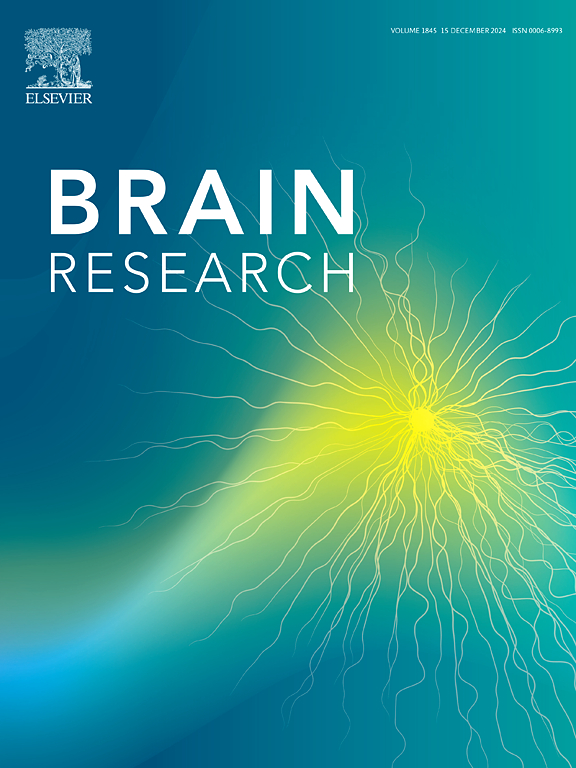Effectiveness of Dipteryx alata Vog. in modulating anxiety, metabolic health, and reproductive parameters in rats treated during pregnancy and lactation
IF 2.7
4区 医学
Q3 NEUROSCIENCES
引用次数: 0
Abstract
The objective of this study was to evaluate the effects of baru oil and almonds on anxiety behavior, and biochemical, physical, and reproductive parameters in Wistar rats treated during gestation and lactation. The rats were randomized into three groups: Control (CG) and two experimental groups, treated with 2,000 mg of baru almond or oil/kg of weight via gavage. Reproductive parameters were analyzed at the end of gestation, and behavioral tests were conducted at the end of lactation. Maternal blood was collected for biochemical profile analysis, along with brain tissue, liver, and feces for fatty acid profile analysis. Colon histology and oxidative stress in the brain were also measured. The results demonstrated that treatment with oil and almonds did not affect reproductive rates. In the elevated plus maze, mothers from the experimental groups showed an increased number of entries, more time spent in the open arms, and a greater number of head dips compared to the CG. In the open field, locomotion increased while grooming decreased in the experimental groups, and defecation was reduced in the almond group. The groups spent more time in the clear area of the light–dark box (LDB) and exhibited higher levels of glutathione and lower levels of malondialdehyde in the brain. Both treatments decreased plasma levels of glucose, total cholesterol, and triglycerides while preserving renal, hepatic, and cardiovascular function. Colon histology and the omega-6/3 ratio in feces indicated an inflammatory profile in the oil group. These findings support the use of baru almonds in the diets of pregnant/lactating women as a safe alternative for managing anxiety and promoting metabolic health.

朱元鸟的功效。在妊娠期和哺乳期大鼠治疗中调节焦虑、代谢健康和生殖参数
本研究的目的是评价巴鲁油和杏仁对妊娠和哺乳期Wistar大鼠焦虑行为、生化、生理和生殖参数的影响。将大鼠随机分为3组:对照组(CG)和2个实验组,分别以2000 mg /kg体重的巴鲁杏仁或巴鲁杏仁油灌胃。在妊娠结束时分析生殖参数,在哺乳结束时进行行为测试。采集母体血液进行生化分析,采集脑组织、肝脏和粪便进行脂肪酸分析。结肠组织学和大脑氧化应激也被测量。结果表明,油和杏仁处理不影响生殖率。在高架+迷宫中,与CG相比,实验组的母亲进入迷宫的次数增加了,张开双臂的时间更长了,头部下垂的次数也更多了。在野外,试验组运动增加,梳理减少,杏仁组排便减少。这些小组在明暗箱(LDB)的清晰区域呆的时间更长,大脑中的谷胱甘肽水平更高,丙二醛水平更低。两种治疗均能降低血糖、总胆固醇和甘油三酯水平,同时保持肾脏、肝脏和心血管功能。结肠组织学和粪便中的omega-6/3比值表明,油组有炎症。这些发现支持在孕妇/哺乳期妇女的饮食中使用巴鲁杏仁作为控制焦虑和促进代谢健康的安全替代品。
本文章由计算机程序翻译,如有差异,请以英文原文为准。
求助全文
约1分钟内获得全文
求助全文
来源期刊

Brain Research
医学-神经科学
CiteScore
5.90
自引率
3.40%
发文量
268
审稿时长
47 days
期刊介绍:
An international multidisciplinary journal devoted to fundamental research in the brain sciences.
Brain Research publishes papers reporting interdisciplinary investigations of nervous system structure and function that are of general interest to the international community of neuroscientists. As is evident from the journals name, its scope is broad, ranging from cellular and molecular studies through systems neuroscience, cognition and disease. Invited reviews are also published; suggestions for and inquiries about potential reviews are welcomed.
With the appearance of the final issue of the 2011 subscription, Vol. 67/1-2 (24 June 2011), Brain Research Reviews has ceased publication as a distinct journal separate from Brain Research. Review articles accepted for Brain Research are now published in that journal.
 求助内容:
求助内容: 应助结果提醒方式:
应助结果提醒方式:


